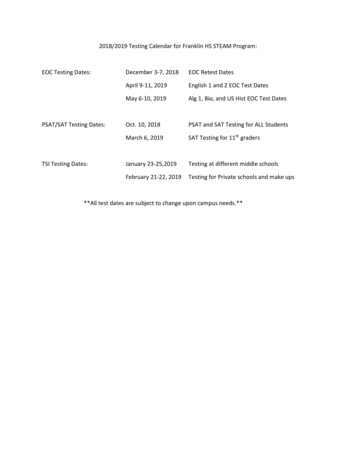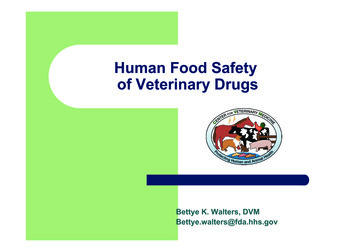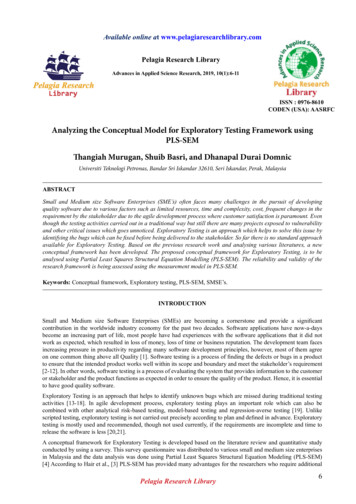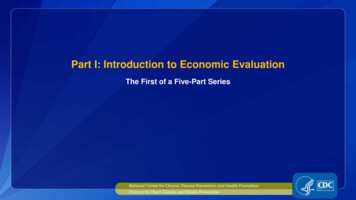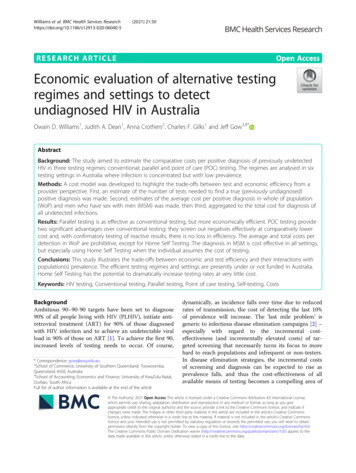
Transcription
Williams et al. BMC Health Services (2021) 21:30RESEARCH ARTICLEOpen AccessEconomic evaluation of alternative testingregimes and settings to detectundiagnosed HIV in AustraliaOwain D. Williams1, Judith A. Dean1, Anna Crothers2, Charles F. Gilks1 and Jeff Gow3,4*AbstractBackground: The study aimed to estimate the comparative costs per positive diagnosis of previously undetectedHIV in three testing regimes: conventional; parallel and point of care (POC) testing. The regimes are analysed in sixtesting settings in Australia where infection is concentrated but with low prevalence.Methods: A cost model was developed to highlight the trade-offs between test and economic efficiency from aprovider perspective. First, an estimate of the number of tests needed to find a true (previously undiagnosed)positive diagnosis was made. Second, estimates of the average cost per positive diagnosis in whole of population(WoP) and men who have sex with men (MSM) was made, then third, aggregated to the total cost for diagnosis ofall undetected infections.Results: Parallel testing is as effective as conventional testing, but more economically efficient. POC testing providetwo significant advantages over conventional testing: they screen out negatives effectively at comparatively lowercost and, with confirmatory testing of reactive results, there is no loss in efficiency. The average and total costs perdetection in WoP are prohibitive, except for Home Self Testing. The diagnosis in MSM is cost effective in all settings,but especially using Home Self Testing when the individual assumes the cost of testing.Conclusions: This study illustrates the trade-offs between economic and test efficiency and their interactions withpopulation(s) prevalence. The efficient testing regimes and settings are presently under or not funded in Australia.Home Self Testing has the potential to dramatically increase testing rates at very little cost.Keywords: HIV testing, Conventional testing, Parallel testing, Point of care testing, Self-testing, CostsBackgroundAmbitious 90–90-90 targets have been set to diagnose90% of all people living with HIV (PLHIV), initiate antiretroviral treatment (ART) for 90% of those diagnosedwith HIV infection and to achieve an undetectable viralload in 90% of those on ART [1]. To achieve the first 90,increased levels of testing needs to occur. Of course,* Correspondence: gowj@usq.edu.au3School of Commerce, University of Southern Queensland, Toowoomba,Queensland 4350, Australia4School of Accounting, Economics and Finance, University of KwaZulu-Natal,Durban, South AfricaFull list of author information is available at the end of the articledynamically, as incidence falls over time due to reducedrates of transmission, the cost of detecting the last 10%of prevalence will increase. The ‘last mile problem’ isgeneric to infectious disease elimination campaigns [2] –especially with regard to the incremental costeffectiveness (and incrementally elevated costs) of targeted screening that necessarily turns its focus to morehard to reach populations and infrequent or non-testers.In disease elimination strategies, the incremental costsof screening and diagnosis can be expected to rise asprevalence falls, and thus the cost-effectiveness of allavailable means of testing becomes a compelling area of The Author(s). 2021 Open Access This article is licensed under a Creative Commons Attribution 4.0 International License,which permits use, sharing, adaptation, distribution and reproduction in any medium or format, as long as you giveappropriate credit to the original author(s) and the source, provide a link to the Creative Commons licence, and indicate ifchanges were made. The images or other third party material in this article are included in the article's Creative Commonslicence, unless indicated otherwise in a credit line to the material. If material is not included in the article's Creative Commonslicence and your intended use is not permitted by statutory regulation or exceeds the permitted use, you will need to obtainpermission directly from the copyright holder. To view a copy of this licence, visit http://creativecommons.org/licenses/by/4.0/.The Creative Commons Public Domain Dedication waiver ) applies to thedata made available in this article, unless otherwise stated in a credit line to the data.
Williams et al. BMC Health Services Research(2021) 21:30investigation by which to gear resources and publichealth interventions.The HIV prevalence in Australia among adults aged15 years and older is estimated to be 0.14% in 2018 [3].Transmission of HIV in Australia continues to occurprimarily through male-to-male sexual contact (63% ofall infections) resulting in a concentrated epidemicamong men who have sex with men (MSM) (prevalenceof 7.9%) [3]. In 2017, estimates suggest that 2899 (11%)people living with HIV were undiagnosed and amongHIV positive MSM, 9% were undiagnosed [3]. Australia,therefore, needs to explore and consider cost effectivemeans of detecting the last 10%.In this context, this study aims to analyse the costs ofmaking a HIV positive diagnosis using the three maintesting regimes available electively in Queensland,Australia: conventional; parallel; and point of care (POC)testing; in six common testing settings: Private GeneralPractice (GP); Public Sexual Health Clinic (SHC); Community Peer Organisation led General Practice (Community GP); Community Organisation led VolunteerPeer Clinic; Community Organisation led Salaried PeerClinic; and Private at Home. The study did not considertesting in hospital settings or screening (blood and organsafety).MethodsAimA model was developed to compare costs from the service provider perspective and to illustrate the trade-offsbetween test effectiveness (mainly arising from the sensitivity of the test technologies) and the economic efficiency associated with the application of these differentregimes in six different testing settings.The model seeks to demonstrate how configurationsof testing technologies, regimes and settings and patientpathways can be displayed in a manner that is more informative than those generated by decision tree models.A further objective is also to generate a relatively simplemodel (or framework) that accommodates the sensitivities of the testing technologies used in each of threetesting regimes and six settings in combination with therates of prevalence and incidence in the whole of population (WoP) and the priority population of men whohave sex with men (MSM).HIV testing regimesThere are three regimes that are most commonly usedfor elective HIV testing/screening in Australia: Conventional EIA (enzyme-linked immunoassay) laboratorytesting; Parallel testing; and POC testing including HIVself-testing (HIVST). The diagnostic standard inAustralia requires the reactive/positive result of the initial screening test to be confirmed by a laboratory basedPage 2 of 12confirmatory Western Blot (WB) or additional supplementary blood test. Establishing a true positive diagnosisinvolves individuals entering one of three HIV testing regimes. Each involves various different combinations ofinitial and confirmatory testing technologies as part ofthe pathway to confirmed diagnosis.The conventional regime is mainly used in GP clinicswhere the vast majority of testing for HIV and othersexually transmissible infections (STI) now occurs andin SHC [4].In parallel testing both conventional EIA testing andrapid POC testing (DHC) are performed simultaneouslyat the point of testing by a health professional or appropriately trained testing facilitator [5, 6]. Parallel testingcan increase the number of tests used in low prevalencecountries compared to conventional testing. However, itis efficient as it enables results to be concordantly confirmed by two different initial assays at one point of service [7], thus reducing the need to wait for results or forreturn visits, both identified as barriers to HIV testing[8–11].The POC testing regime allows testing to occur innon-clinical settings by medical and non-medicalpersonnel with results available at the time and place oftesting or at home as is the case with HIVST [5, 12].The rapid POC tests do not provide confirmatory diagnostic evidence of a HIV infection; and patients with reactive results require confirmation of a positive result byentering into the conventional or parallel testing regimes. The three regimes are represented diagrammatically in Fig. 1.HIV testing settingsAll six settings were based in Brisbane, the capital city inthe Australian state of Queensland, which are representative of the whole of Australia. Conventional testingpathway is conducted in SHC and Private GP setting.Parallel testing pathway is mainly available at community GP clinics, community volunteer peer clinics andcommunity salaried peer clinics. POC testing pathwayincluded both rapid POC testings and HIVST.Cost modelA cost model was constructed in Excel to compare thecost per positive diagnosis associated with two populations, three regimes and six settings and incorporating anumber of inputs. Each testing regime can result in anumber of possible outcomes.For example, conventional testing could produce fourpossible outcomes: a true positive, a true negative, a falsepositive, or a false negative. Identifying all possible outcomes enables the calculation of the total costs of eachoutcome, the likelihood of each of these outcomes andthe calculation of the average cost per person tested.
Williams et al. BMC Health Services Research(2021) 21:30Page 3 of 12Fig. 1 HIV Testing Regime Pathways to Confirmed Diagnosis. Note: DHC Alere Determine HIV-1/2 Ag/Ab Combo Test, EIA fourth generationenzyme immunoassay test, HIV Diagnosis confirmed HIV positive diagnosis, Rapid POC Test Alere Determine HIV-1/2 Ag/Ab Combo Test orOraQuick ADVANCE HIV Home Test, WB Western Blot Test, reactive test result, - nonreactive test resultThe probability of each outcome is dependent on threemain model inputs: first, the probability of finding anundiagnosed HIV infection in both whole of population(WoP) and MSM; second, the sensitivity (Sen) and specificity (Spec) of each testing technology; and third, thecost inputs for each testing regime.For example, the average cost per person tested forthe conventional testing regime is calculated as:¼ ðP HIV SenEIA SenWB Þ AC per True HIV PositiveEIAþ;WBþefficiency forms part of the calculation of the probabilityof a finding a true undiagnosed case in each of the twopopulations. This factor provides a benchmark to evaluate and compare the economic efficiency of each of thethree regimes and six settings.Rate of undiagnosed HIV cases in populationi1¼P HIVþðP HIV ð1 SenEIA ÞÞ AC per False HIV NegativeEIA þðð1 P HIV Þ SpecEIA Þ AC per True HIV negativeEIA þðð1 PHIV Þ ð1 SpecEIA Þ SpecWB Þ AC per False HIV PositiveEIAþ;WB Then the average number of tests needed to find apositive and previously undiagnosed HIV case for the1conventional testing is: ¼ PHIV SenEIA SenWB:The average cost per positive diagnosis is derived as:¼ Average Cost per person tested Average number of tests required for a positive diagnosisDetails and assumptions for the different screeningstrategies modelled are presented below. The testDataClinical test effectivenessThe following testing technologies and documented sensitivities and specificities were used for calculations:Architect HIV Ag/Ab Combo assay which is generallyused in Australia for conventional testing [Sensitivity99.94% (95% CI, 99.79, 100%); Specificity 99.50% (95%CI, 99.31, 99.64)] [13]; Rapid Alere Determine Combowidely used in Queensland for POC testing [Sensitivity99.4% (95% CI, 96.6, 100%); Specificity 99.2% (95% CI,98.2, 99.7)] [14]; and the OraQuick ADVANCE HIV
Williams et al. BMC Health Services Research(2021) 21:30Home Test for self-testing as this particular kit is the closestto market approval in Australia [Sensitivity 91.67% (95% CI,84.24, 96.33%); Specificity 99.98% (95% CI, 99.89, 100)] [15].Probability of detecting an undiagnosed HIV infectionThe probability of detection is derived by deductionfrom the estimates of the number of undiagnosed HIVpositive cases.Probability of finding an undiagnosed HIV case in populationiNumber of undiagnosed HIV cases in populationi¼populationi sizeIn 2014, the Australian WoP aged 15 years or greaterwas 18,754,954 [16]. The MSM population was estimatedat 305,783 using data from the 2nd Australian Study ofHealth and Relationships Survey [17] and demographic information from the Australian Bureau of Statistics [16]. Itshould be noted that there are limited data available onthe relative size and distribution of the MSM populationin the states and territories of Australia, and any enumeration of this population at the sub-national level is complex and subject to certain assumptions. Thus, there is ahigh degree of uncertainty in these estimates.Page 4 of 12Data on HIV incidence and estimated undiagnosedprevalence for both the WoP and MSM populations wasderived from the Australia Annual HIV Surveillance Report published in 2015 [18]. National rates of undiagnosed HIV prevalence were used because only nationalpopulation estimates for undiagnosed prevalence in thegeneral and MSM population are available. Additionally,the latest survey data reports only national prevalence ofthe number of men who identify as MSM. The numberof undiagnosed HIV positive people in the general population in 2014 was estimated to be 3350 (CI 95%, 21004670) and in the MSM population 1848 (CI 95%, 850–2896). Thus, mass universal testing in WoP would yielda 0.0179% probability of finding an undiagnosed HIV infection per person tested and a 0.6044% probability inthe MSM population assuming everyone has an equalchance of being tested.Cost data collectionFrom February to April 2016 costing information wascollected from community sites, SHC and GP clinics.Costs incurred by the health system include: consultlength; staff salary; consult costs including MedicareTable 1 Conventional Testing Regime: Private General Practice Clinic Setting – (Funded by Federal Government – Medicare)Probability of True HIV Positive(PHIV)Probability of True HIV Negative(1 PHIV)OutcomesHIV Positive(EIA & WB )False HIVNegative(EIA-)False HIV Positive(EIA & WB-)True HIVNegative(EIA-)Probability of result(PHIV SenEIA SenWB)PHIV (1 SenEIA)((1 PHIV) (1 SpecEIA) SpecWB)(1 PHIV) SpecEIA20 min20 min20 min20 minInputsVisit 1: Initial ScreeningConsult time111Medicate Rebate 71.70 71.70 71.70 71.701StaffingGPGPGPGPEIA 15.652 15.652 15.652 15.652WB confirmatory 29.003Pathology costs 29.003Visit 2: Test ResultsConsult time40 min20 min20 min20 minMedicate Rebate 105.554 71.701 71.701 71.701GPGPGPGPTotal Cost of Each OutcomeStaffing 221.90 159.05 188.05 159.05Average cost (AC) per person tested (PHIV SenEIA SenWB) AC per True HIV PositiveEIA , WB (PHIV (1 SenEIA)) AC per False HIV NegativeEIA ((1 PHIV) SpecEIA) AC per True HIV NegativeEIA ((1 PHIV) (1 SpecEIA) SpecWB)) AC per False HIV PositiveEIA , WB Average number of tests for a positivediagnosis¼ PHIV Sen1EIA SenWBNote: AC Average Cost, EIA fourth generation enzyme immunoassay test, GP General Practitioner, P Probability, Sen Sensitivity, Spec Specificity, WB Western BlotTest, reactive test result, nonreactive test result1 Medicare Rebate Item 36; 2 Medicare Rebate Item 69,384; 3 Medicare Rebate Item 69,387; 4 Medicare Rebate Item 44
Williams et al. BMC Health Services Research(2021) 21:30Page 5 of 12comparison, home Self Testing results in slightly higherrates at one per 6111 per person in the WoP and oneper 180 in the MSM population.Benefits Schedule rebates from the publicly funded universal health care system operated by the Commonwealth of Australia Department of Human Services; testcosts; and confirmatory laboratory testing for reactiveresults. Costs were calculated from the health care provider’s perspective, with the exception of HIVST, whichwas based on the retail price of the test kit establishedelsewhere [19].The cost of testing in the six settings and by HIV status are outlined in Tables 1, 2, 3, 4, 5 and 6.CostsCosts vary across regimes and settings depending on thenumber of visits, labour costs and types of labour used,and the number (if any) of pathology tests required.The estimated cost per HIV diagnosis in the six settings for WoP were found to be extremely high, exceptfor HIVST, when private costs were ignored (Table 7).Secondly, the cost per diagnosis for the MSM populationwere considerably lower due to the higher prevalenceand therefore ease of detection, compared to WoP(Table 8).The results of this study demonstrate that both test effectiveness and economic efficiency are constituents incomparing cost per HIV diagnosis in all testing settings.First, it is clear that clinicians’ wages are significantdrivers of the costs of individual HIV testing and its detection. Conventional testing with clinical nurses andparallel testing with volunteer peer testers are threetimes more cost effective than either regime with GP/doctor’s wages. Parallel testing saves costs compared toResultsTest efficiency in detecting undiagnosed HIV casesConventional and parallel testing regimes were found tobe more efficient (higher sensitivity and specificity) indetecting a confirmed positive HIV diagnosis than POCtesting, resulting in the number of tests required to detect HIV being lower for the former regimes comparedto the latter (Tables A1 to A6b in Additional file 1).Conventional, parallel and Point of Care testing conducted at a community organisation each detect undiagnosed cases at an approximate rate of one per 5602 andone per 5787 per person tested respectively, and in WoPat 165 and 171, respectively in the MSM population. InTable 2 Conventional Testing Regime: Public Sexual Health Clinic Setting (Funded by State Government)True HIV Positive (PHIV )True HIV Negative (1 PHIV)OutcomesHIV Positive(EIA & WB )False HIVNegative(EIA-)False HIV Positive(EIA & WB-)True HIVNegative(EIA-)Probability of result(PHIV SenEIA SenWB )(PHIV (1 SenEIA))((1 PHIV) (1 SpecEIA) SpecWB)(1 PHIV) SpecEIAInputsVisit 1: Initial ScreeningConsult time30 Min30 Min30 Min30 MinStaff Wage (Rate/Hour): 45.12 45.12 45.12 45.12StaffingClinical NurseClinical NurseClinical NurseClinical NurseEIA 18.54 18.54 18.54 18.54WB confirmatory 84.54Pathology costs 84.54Visit 2: Test ResultsConsult time60 Min30 Min30 Min30 MinStaff Wage (Rate/Hour): 78.00 45.12 45.12 45.12StaffingStaff specialist(Level 18)Clinical NurseClinical NurseClinical NurseTotal Cost of Each Outcome 203.64 63.67 148.21 63.67Average cost per person tested (PHIV SenEIA SenWB) AC per True HIV PositiveEIA , WB (PHIV (1 SenEIA)) AC per False HIV NegativeEIA ((1 PHIV) SpecEIA) AC per True HIV NegativeEIA ((1 PHIV) (1 SpecEIA) SpecWB)) AC per False HIV PositiveEIA , WB Average number of tests for a positivediagnosis¼ PHIV Sen1EIA SenWBNote: AC Average Cost, EIA fourth generation enzyme immunoassay test, P Probability, Sen Sensitivity, Spec Specificity, WB Western Blot Test, reactive test result, nonreactive test result
Williams et al. BMC Health Services Research(2021) 21:30Page 6 of 12Table 3 Parallel Testing Regime: Community Peer Organisation Bulk Billing GP Clinic Setting (Funded by Federal Government Medicare and State Government)True HIV Negative (1 PHIV)True HIV Positive (PHIV)OutcomesDHC ,EIA , WB DHC-, EIA ,WB DHC ,EIA-DHC-,EIA-DHC , EIA-DHC , EIA , WB-DHC-, EIA ,WB-DHC-, EIA-Probability ofresult(PHIV SenDHC SenEIA SenWB)(PHIV (1 SenDHC) SenEIA SenWB )(PHIV SenDHC (1 SenEIA))(PHIV (1 SenDHC) (1 SenEIA))((1 PHIV) (1 SpecDHC) SpecEIA)((1 PHIV) (1 SpecDHC) (1 SpecEIA) SpecWB((1 PHIV) SpecDHC (1 SpecEIA) SpecWB )((1 PHIV) SpecDHC SpecEIA )20 min20 min20 min20 min20 min20 min20 min)InputsVisit 1: Initial ScreeningConsult time20 min1111111MedicateRebate 71.70 71.70 71.70 71.70 71.70 71.70 71.70 71.701StaffingGPGPGPGPGPGPGPGP 11 11 11 11 11 11 11 15.652 15.652 15.652 15.652 15.65233Pathology costsRapid Alere 11Determine Test(DHC)EIAWBconfirmatory 15.652 15.65233 29.00 29.00 29.00 29.0020 min20 min 15.652Visit 2: Test ResultsConsult timeMedicareRebateStaffing40 min40 min4 105.5520 min4 105.5520 min11 71.701 71.701GPGPGP 170.05 199.05 199.05 71.70 71.70GPGPGPTotal Cost of EachOutcome 232.90 232.90 170.05Average cost perperson tested (PHIV SenDHC SenEIA SenWB) AC per True HIV PositiveDHC , EIA , WB (PHIV (1 SenDHC) SenEIA SenWB) AC per True HIV PositiveDHC , EIA , WB (PHIV SenDHC (1 SenEIA)) AC per False NegativeDHC , EIA (PHIV (1 SenDHC) (1 SenEIA)) AC per False NegativeDHC , EIA ((1 PHIV) (1 SpecDHC) SpecEIA) AC per False HIV PositiveDHC , EIA ((1 PHIV) (1 SpecDHC) (1 SpecEIA) SpecWB) AC per False HIV PositiveDHC , EIA , WB ((1 PHIV) SpecDHC (1 SpecEIA) SpecWB) AC per False HIV PositiveDHC , EIA , WB ((1 PHIV) SpecDHC SpecEIA) AC per True NegativeDHC , EIA Average numberof tests for apositive diagnosis¼ ðPHIV SenDHC SenEIA SenWB ÞþðP1HIV ð1 SenDHC Þ SenEIA SenWB Þ 98.35 98.35Note: AC Average Cost, DHC Alere Determine HIV-1/2 Ag/Ab Combo Test, EIA fourth generation enzyme immunoassay test, GP General Practitioner, P Probability,Sen Sensitivity, Spec Specificity, WB Western Blot Test, reactive test result, nonreactive test result. 1 Medicare Rebate Item 36; 2 Medicare Rebate Item69,384; 3 Medicare Rebate Item 69,387; 4 Medicare Rebate Item 44the GP/doctor conventional setting because there are nofollow-on visits for negative rapid results. There is, again,no loss of test effectiveness in the model due to thecombination of conventional and POC testing beingused for those with an initial reactive result.Second, public SHC are far less costly (at less than halfthe cost) than conventional GP testing, largely due tothe substantial salary savings of using nurses in combination with doctor/medical officers where the latter areonly present for the event of a positive diagnosis.Third, the peer rapid POC testing clinic is less expensive than almost all settings because it requires clients toonly attend the clinic for an initial test overseen by a lowcost peer tester, unless in the case of a reactive resultwhen clients are referred for confirmatory testing andrequire a doctor/GP services. The standard rapid POCtest results in a relatively small loss in test effectiveness.However, the average cost per test is significantly lowerbecause of a combination of the lower peer salary levelscompared to nurse and doctor/medical officers includingGPs, and there is no need for a follow up visit to receivea result (either non-reactive or reactive) even when testing a comparatively higher prevalence MSM clientele.What primarily determines cost effectiveness of POC
Williams et al. BMC Health Services Research(2021) 21:30Page 7 of 12Table 4 Parallel Testing Regime: Community Peer Testing Service using Volunteer Peer Nurse Setting (Funded by FederalGovernment - Medicare and State Government)True HIV Negative (1 PHIV)True HIV Positive (PHIV)OutcomesDHC ,EIA , WB DHC-, EIA ,WB DHC ,EIA-DHC-,EIA-DHC , EIA-DHC , EIA , WB-DHC-, EIA ,WB-DHC-, EIA-Probability ofresult(PHIV SenDHC SenEIA SenWB )(PHIV (1 SenDHC) SenEIA SenWB )(PHIV SenDHC (1 SenEIA))(PHIV (1 SenDHC) (1 SenEIA))((1 PHIV) (1 SpecDHC) SpecEIA )((1 PHIV) (1 SpecDHC) (1 SpecEIA) SpecWB((1 PHIV) SpecDHC (1 SpecEIA) SpecWB )((1 PHIV) SpecDHC SpecEIA ))InputsVisit 1: Initial Screening – Volunteer Peer Testing FacilitatorsConsult time20 min20 min20 min20 min20 min20 min20 min20 minStaff Wage(Rate/Hour): 0 0 0 0 0 0 0 eVolunteerNurseVolunteerNurseVolunteer NurseVolunteer NurseVolunteerNurse 11 11 11 11 11 11 11 15.651 15.651 15.651 15.651 15.65122Pathology costsRapid Alere 11Determine TestEIA testWBconfirmatory 15.651 15.65122 29.00 29.00 29.00 29.0020 min20 min 15.651Visit 2: Test Results – Community Peer Organisation Bulk Billing GP ClinicConsult timeMedicateRebateStaffing40 min40 min3 105.5520 min3 105.5520 min44 71.704 71.704GPGPGP 98.35 127.35 127.35 71.70 71.70GPGPGPTotal Cost of EachOutcome 161.20 161.20 98.35Average cost perperson tested (PHIV SenDHC SenEIA SenWB) AC per True HIV PositiveDHC , EIA , WB (PHIV (1 SenDHC) SenEIA SenWB) AC per True HIV PositiveDHC , EIA , WB (PHIV SenDHC (1 SenEIA)) AC per False NegativeDHC , EIA (PHIV (1 SenDHC) (1 SenEIA)) AC per False NegativeDHC , EIA ((1 PHIV) (1 SpecDHC) SpecEIA) AC per False HIV PositiveDHC , EIA ((1 PHIV) (1 SpecDHC) (1 SpecEIA) SpecWB) AC per False HIV PositiveDHC , EIA , WB ((1 PHIV) SpecDHC (1 SpecEIA) SpecWB) AC per False HIV PositiveDHC , EIA , WB ((1 PHIV) SpecDHC SpecEIA) AC per True NegativeDHC , EIA Average numberof tests for apositive diagnosis¼ ðPHIV SenDHC SenEIA SenWB ÞþðP1HIV ð1 SenDHC Þ SenEIA SenWB Þ 26.65 26.65Note: AC Average Cost, DHC Alere Determine HIV-1/2 Ag/Ab Combo Test, EIA fourth generation enzyme immunoassay test, GP General Practitioner, P Probability,Sen Sensitivity, Spec Specificity, WB Western Blot Test, reactive test result, nonreactive test result. 1 Medicare Rebate Item 69,384; 2 Medicare Rebate Item69,387; 3 Medicare Rebate Item 44; 4 Medicare Rebate Item 36settings, is how inexpensive it is to screen negatives andnot how expensive it is to diagnose positives.Sensitivity analysisThis was conducted on variables of interest: HIV prevalence levels; sensitivity and specificity of the testing technologies as well as labour time and costs. No significant( 10%) variation was evidenced in the cost results as aresult of changes to any of the parameters.DiscussionThe cost results demonstrate that testing with rapidPOC technologies, both peer facilitated and performedin the home/private, are the most cost effective means ofachieving undiagnosed HIV diagnosis in WoP and MSMpopulations. This result holds irrespective of the lossesin test effectiveness caused by the relatively lower sensitivity of the POC tests. Thus, in low prevalence countries like Australia, the biggest cost consideration forwhole of population HIV screening should be howcheaply a screening modality can identify and diagnosenegative cases, rather than how cheaply it can detectpositive cases. Testing regimes that can screen but cannot confirm a diagnosis are highly cost effective. For example, community clinics using rapid POC testing canscreen a negative case for under 35 and confirm a positive case for less than 300, whilst HIVST is dramaticallyless expensive, with screening of negative cases is of a
Williams et al. BMC Health Services Research(2021) 21:30Page 8 of 12Table 5 Point of Care Testing Regime: Community Peer Testing Service Setting (Funded by State Government)True HIV Negative (1 PHIV)True HIV Positive (PHIV)OutcomesDHC , EIA ,WB DHC-DHC , EIA-Probability of result(PHIV SenDHC SenEIA SenWB )(PHIV (1 (PHIV SenDHC (1 SenEIA))SenDHC))DHC , EIA , WB-DHC EIA-DHC-((1 PHIV) (1 SpecDHC) (1 SpecEIA) SpecWB )((1 PHIV) (1 SpecDHC) SpecEIA )(1 PHIV) SpecDHCInputsVisit 1: Initial Screening - Community Peer Testing ServiceConsult time60 Min30 Min60 Min60 Min60 Min30 MinStaff Wage (Rate/Hour): 45 45 45 45 45 45StaffingPeerPeerPeerPeerPeerPeer 11 11 11 11 11 11Pathology costsRapid Alere (DHC)Determine TestReferral to Bulk Billing GP for Confirmatory TestingVisit 1: Initial ScreeningConsult time20 min20 min20 min20 minMedicate Rebate 71.701 71.701 71.701 71.701StaffingGPGPGPGP 15.652 15.652Pathology costsEIA testWB confirmatory 15.6523 15.6523 29.00 29.00Visit 2: Test ResultsConsult time40 min20 min420 min 105.55 71.70 71.70 71.701StaffingGPGPGPGP 215.05 244.05 215.05 33.50120 minMedicate RebateTotal Cost of Each Outcome 277.901 33.50Average cost per persontested (PHIV SenDHC SenEIA SenWB) AC per True PositiveDHC , EIA , WB (PHIV (1 SenDHC)) AC per False NegativeDHC (PHIV SenDHC (1 SenEIA)) AC per False NegativeDHC , EIA ((1 PHIV) SpecDHC) AC True NegativeDHC ((1 PHIV) (1 SpecDHC) SpecEIA) False PositiveDHC , EIA ((1 PHIV) (1 SpecDHC) (1 SpecEIA) SpecWB) False PositiveDHC , EIA , WB Average number of testsfor a positive diagnosis1¼ PHIV SenDHC SenEIA SenWBNote: AC Average Cost, DHC Alere Determine HIV-1/2 Ag/Ab Combo Test, EIA fourth generation enzyme immunoassay test, GP General Practitioner, P Probability,Sen Sensitivity, Spec Specificity, WB Western Blot Test, reactive test result, nonreactive test result. 1 Medicare Rebate Item 36; 2 Medicare Rebate Item69,384; 3 Medicare Rebate Item 69,387; 4 Medicare Rebate Item 44negligible cost especially with government supplied ‘free’POC test kits.Costs per diagnosis rise dramatically when prevalenceis low [20]. Screening low-risk populations with moreexpensive and sensitive technologies is not cost-effectivewhen prevalence is low [21]. Thus, it would make senseto use cheaper and less efficient (or effective) test technologies if cost is the only consideration. For example,results of this study suggests a HIV diagnosis made in aGP practice costs almost 900,000, but a HIV diagnosismade in a MSM community clinic using POC costs lessthan 7000.The focus on cost per diagnosis in other studies oftenfails to provide a breakdown of what are the constituentdrivers of cost or what were the factor inputs into theparticular model (in this study these were p
Fig. 1 HIV Testing Regime Pathways to Confirmed Diagnosis. Note: DHC Alere Determine HIV-1/2 Ag/Ab Combo Test, EIA fourth generation enzyme immunoassay test, HIV Diagnosis confirmed HIV positive diagnosis, Rapid POC Test Alere Determine HIV-1/2 Ag/Ab Combo Test or








